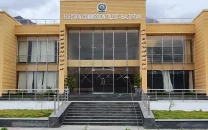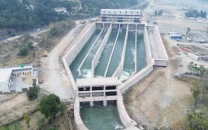Endangered: Rapid progress affecting G-B’s trout population
Water from streams is siphoned for dams and other projects

Experts survey the lake to see how suitable it is for fish. PHOTO: SHABBIR MIR/EXPRESS
“There was a time when there were many fish in the streams and lakes, but it is not the same anymore and the situation is getting worse with each passing day,” a conservationist at the World Wide Fund for Nature office in G-B, Rehmat Ali, shared with The Express Tribune. “We are implementing a project to assess the distribution and existing stock of rivers, lakes and streams in the region.”
In the blue
Called Protecting Native Fish Species through Sustainable Harvest of Carnivorous Trout Species in Cold Water of G-B, the project is being implemented by WWF and the fisheries department of G-B.
Ali said that since the rapid construction work is threatening aquaculture, the project will aim to protect and conserve the population of native fish species.

The water selected for sampling include that of Hundrab, Darle, Jarbazoo, Naltar and Gasho lakes and streams of Ghizer River and Khanbari Nullah. “A variety of fish sampling methods were used in the study to see how suitable the lakes and streams can be for fish.”
He added the most productive lakes are Hundrab and Gasho where there is a sizeable fish stock, whereas the most diverse lake is Jarbazoo in Shigar. “Hundrab has a large number of fish because there was a ban on fishing in the area for the past three years.” On the other hand, he said Jarbazoo Lake has four species of fish with great potential to stock both native and unusual species. However, Ghizer River, Diamer’s Khunbari Nullah and Chilas have waters where native fish breed during the monsoon.
Help from locals
Ali said the population of trout and native fish can be retained if continuous stocking programmes are carried out. “However, this plan cannot be materialise without the involvement of locals and regulatory agencies.”
The nine native species of trout found in the selected areas of the project include Schizothorax plagiostomus, Schizothorax esocinus or Chirruh snowtrout, Schizothorax skurduensis, Racoma labiata, Schizopyge curvifrons or Sattar snowtrout, Schizopyge dainellii, Triplophysa microps, Triplophysa yasinensis and Glyptosternum reticulatum.
The species that are commercially important include Schizothorax plagiostomus, Schizothorax esocinus and Schizothorax skurduensis.
Published in The Express Tribune, September 9th, 2015.



















COMMENTS
Comments are moderated and generally will be posted if they are on-topic and not abusive.
For more information, please see our Comments FAQ